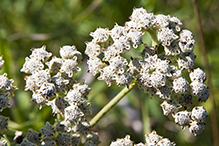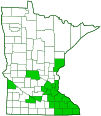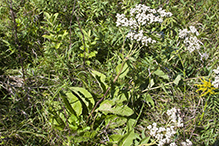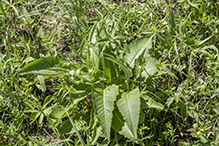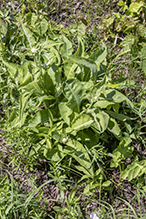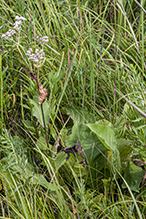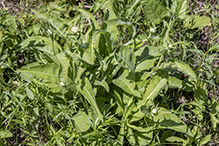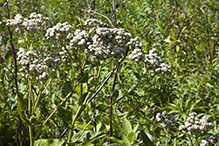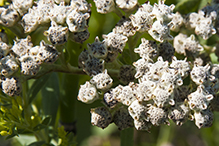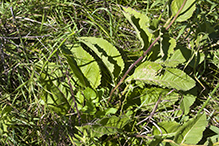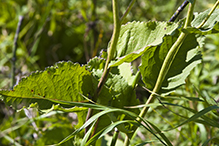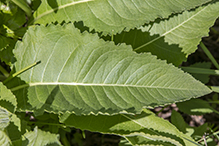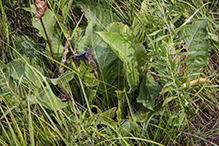wild quinine
(Parthenium integrifolium)
Conservation • Description • Habitat • Ecology • Use • Distribution • Taxonomy
Conservation Status |
|
|||||||
| IUCN Red List | not listed |
|||||||
| NatureServe | N5 - Secure SNR - Unranked |
|||||||
| Minnesota | Endangered |
|||||||
Description |
||
Wild quinine is an erect, long-lived, perennial forb that rises on multiple stems from a thickened, tuberous rootstock, and occasionally from a short rhizome. It can be 12″ to 40″tall, though it is usually no more than 24″ in height. They are usually not colonial. The stems are erect and usually unbranched below the inflorescence. They are rough to the touch and hairless or sparsely to moderately covered with upward-pointed, short, stiff, sharp, appressed hairs. The base of the stem may be hairless or sparsely to moderately covered with softer, more loosely ascending hairs. Stem leaves are alternate. Basal and lower stem leaves are long-stalked, egg-shaped to lance-shaped, 1¼″ to 13¾″ long, and ¾″ to 4¾″ wide. They are long-tapered at the base and angled or tapered to a point at the tip. The upper surface is medium green, rough to the touch, and sparsely to moderately covered with short, stiff hairs. The lower surface is similarly colored and moderately to densely covered with short, spreading hairs. The margins are coarsely toothed or scalloped. They are mostly unlobed but sometimes have a few short lobes near the base. The leaves become smaller and on shorter stalks or stalkless as they ascend the stem. Middle and upper stem leaves are ¾″ to 6″ long. The stalked leaves are angled or tapered to the base. The unstalked leaves are rounded or heart-shaped at the base and are sometimes clasping. They are otherwise similar to the lower leaves. The inflorescence is a dense, more or less flat-topped cluster (corymb) of many heads at the end of the stem. Each flower head is ¼″ to ⅓″ in diameter. There are 5, sometimes six, ray florets and 15 to 35 or more disk florets. Each ray floret is white, 1 ⁄32″ to 1 ⁄16″ long, and egg-shaped to nearly circular. It forms a tube at the base out of which a two-branched style protrudes. The disk florets are white. There is no fragrance. The fruit is a dry, black, ⅛″ to 3 ⁄16″ long cypsela. |
||
Height |
||
12″ to 24″ |
||
Flower Color |
||
White ray florets, white disk florets |
||
Similar Species |
||
|
||
Habitat |
||
Moderate moisture. Upland prairies, savannas. Full sun. |
||
Ecology |
||
Flowering |
||
July to September |
||
Pests and Diseases |
||
|
||
Use |
||
|
||
Distribution |
||||
|
Sources |
|||
| 7/21/2023 | ||||
Nativity |
||||
Native |
||||
Occurrence |
||||
|
||||
Taxonomy |
|||
| Kingdom | Plantae (Plants) | ||
| Division | Tracheophyta (Vascular Plants) | ||
| Subdivision | Spermatophytina (Seed Plants) | ||
| Class | Magnoliopsida (Dicots) | ||
Order |
Asterales (Sunflowers, Bellflowers, Fanflowers, and Allies) | ||
Family |
Asteraceae (Sunflowers, Daisies, Asters, and Allies) | ||
| Subfamily | Asteroideae | ||
| Supertribe | Helianthodae | ||
| Tribe | Heliantheae (Sunflowers and Allies) | ||
| Subtribe | Ambrosiinae (cockleburs, ragweeds, and wild quinines) | ||
| Genus | Parthenium (wild quinines) | ||
Subordinate Taxa |
|||
Five varieties have been described. USDA Plants recognizes two varieties. Most taxonomists do not recognize any varieties. |
|||
Synonyms |
|||
Parthenium auriculatum Parthenium hispidum Parthenium hispidum var. auriculatum Parthenium integrifolium var. auriculatum Parthenium integrifolium var. henryanum Parthenium integrifolium var. hispidum Parthenium integrifolium var. integrifolium Parthenium integrifolium var. mabryanum Parthenium radfordii Parthenium repens |
|||
Common Names |
|||
American feverfew eastern parthenium wild quinine |
|||
Glossary
Clasping
Describing a leaf that wholly or partly surrounds the stem but does not fuse at the base.
Corymb
A flat-topped or convex inflorescence in which the stalked flowers grow upward from various points on the main stem to approximately the same horizontal plane. The outer flowers open first.
Cypsela
A dry, one-chambered, single-seeded fruit, formed from a single carpel, with the seed attached to the membranous outer layer (wall) only by the seed stalk; the wall, formed from the wall of the inferior ovary and also from other tissues derived from the receptacle or hypanthium, does not split open at maturity, but relies on decay or predation to release the contents.
Rhizome
A horizontal, usually underground stem. It serves as a reproductive structure, producing roots below and shoots above at the nodes.

Slideshows |
||
| Parthenium integrifolium WILD QUININE Frank Mayfield |
||

|
||
| Parthenium integrifolium Joshua Mayer |
||
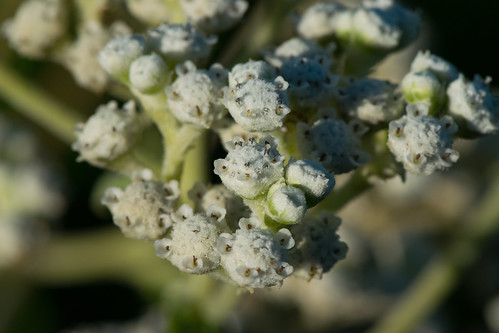
|
||
About
Wild Quinine / American Feverfew |
||

Visitor Videos |
|||
Share your video of this plant. |
|||
| This button not working for you? Simply email us at info@MinnesotaSeasons.com. Attach a video, a YouTube link, or a cloud storage link. |
|||
Other Videos |
|||

Visitor Sightings |
|||||
Report a sighting of this plant. |
|||||
| This button not working for you? Simply email us at info@MinnesotaSeasons.com. Be sure to include a location. |
|||||
|
|||||
MinnesotaSeasons.com Sightings |
|||||

|
Created: Last Updated: © MinnesotaSeasons.com. All rights reserved. |
